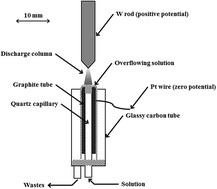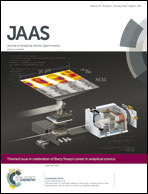Direct elemental analysis of honeys by atmospheric pressure glow discharge generated in contact with a flowing liquid cathode
Abstract
Miniaturized atmospheric pressure glow discharge sustained in a compact discharge cell in contact with a flowing liquid cathode was used for the elemental analysis of honeys by optical emission spectrometry. A simplified sample preparation procedure was proposed and samples of honeys were only dissolved in water and acidified with HCl to a concentration of 0.10 mol L−1. The resulting 1.0% m/v in the case of K and Na and 5.0% m/v in the case of Ca, Cu, Fe, Li, Mg, Mn, Rb and Zn solutions of honeys were directly introduced into the discharge cell acting as the liquid cathode of the discharge. To eliminate matrix effects coming from fructose and glucose, a non-ionic surfactant (Triton X-405) was added to the solutions and this resulted in improved signals of studied elements. For calibration, simple (for K and Na) and matrix-matching (for other elements) standard solutions were used. The method was proved to give reliable results and applied in the analysis of 16 commercial white- to amber-colored honeys with limits of detection at levels of 1.0 (Ca), 0.7 (Cu), 2.5 (Fe), 0.5 (K), 0.02 (Li), 0.2 (Mg), 1.8 (Mn), 0.04 (Na), 0.1 (Rb) and 0.2 (Zn) μg g−1.

- This article is part of the themed collection: Themed issue dedicated to Barry Sharp

 Please wait while we load your content...
Please wait while we load your content...